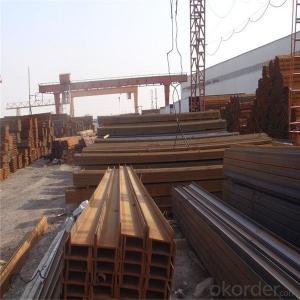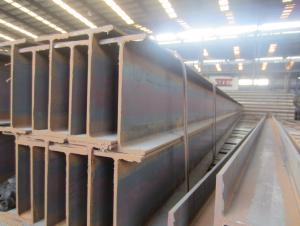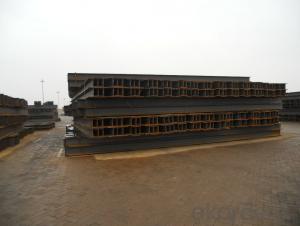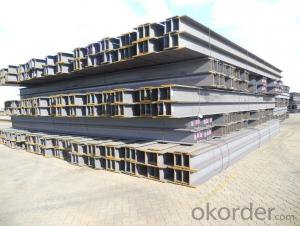GB Standard H Section Steel from China with Good Price
- Loading Port:
- Tianjin
- Payment Terms:
- TT OR LC
- Min Order Qty:
- 500 m.t
- Supply Capability:
- 10000 m.t/month
OKorder Service Pledge
OKorder Financial Service
You Might Also Like
Item specifice
Quick Details
Place of Origin: | Jiangsu, China (Mainland) | Grade: | SS400, SS400,ST37-2, A36, S235JR, Q235 | Technique: | Hot Rolled |
Thickness: | 8mm | Application: | construction | Length: | 6m-16m |
Standard: | JIS, ASTM,BS,EN | Flange Width: | 50-34mm | Flange Thickness: | 7-34mm |
Web Width: | 100-900mm | Web Thickness: | 5-30mm | Brand Name: | JZZHD |
Model Number: | 350mm*175mm*7mm*11mm | Name: | Steel h beam structure material/ construction steel | Certificate: | SGS,ISO,CE,TUV |
We can provide qualify goods,competitive price and speedy delivery.

Products Description
Description | High Frenquency Thin-walled H Beam | |
Product Name | H Beam | |
Specification | Height:75-500mm Width:50-250mm | |
Standard | GB700-1998,GB/T1591-1994 | |
Material | Q235B,Q345B | |
Application | a. Bridge and post structures in industry and civil use of steel construction. | |
Certificates | ISO,SGS,BV,TUV,Lloyd | |
MOQ | 20 tons or according to customers’ requirement. | |
Port of Delivery | Tianjin Port of China | |
Remarks | We can provide qualify goods,competitive price and speedy delivery |
Packaging & Delivery
Packaging Details: | Packed with waterproof paper and steel banding. |
Delivery Detail: | 15-25 |
FAQ
1. How can I get some samples?
We are honored to offer you samples. New clients are expected to pay for the courier cost. The samples are free for you.
2 Do you have any certificates?
Our products passed inspection of SGS, FDA, and CE Quality is priority! Every worker keeps the QC from the very beginning to the very end, Quality control department especially responsible for quality checking in each process.
3 Can your factory print or emboss my logo on the goods?
Yes, we can print or emboss the logo on the goods or their packing box.
4 What information should I let you know if I want to get a quotation?
1) The specification of products (length x width x thickness);
2) The temper and alloy.
3) The final product you will use to be made
4 It will be better if you can show us the pictures or design sketch. Samples will be best for clarifying. If not, we will recommend relevant products with details for reference.We usually produce goods based on customers
Samples or based on customers’ picture, logo, sizes etc.
- Q:How do steel H-beams perform in terms of fire resistance?
- Steel H-beams exhibit excellent fire resistance capabilities. With their unique composition and structural design, they possess a high melting point and are less susceptible to deformation or collapse when exposed to extreme temperatures. Consequently, they exhibit exceptional durability and maintain their structural integrity for extended periods during fire incidents. To further enhance their fire resistance, fireproofing materials such as intumescent coatings or fire-resistant insulation are applied to steel H-beams. These materials form a protective layer on the beam's surface, which expands upon exposure to heat, creating an insulating barrier. This barrier effectively retards the transfer of heat to the steel, thereby augmenting its fire resistance and preventing premature failure. Moreover, steel H-beams boast remarkable load-bearing capacities, even in elevated temperatures. Consequently, they continue to support the weight of the structure in the event of a fire, averting catastrophic collapses. This feature is particularly crucial in buildings and structures where fire safety is of paramount importance, such as high-rise buildings, industrial facilities, and infrastructure projects. It is important to note that despite their commendable fire resistance, steel H-beams are not entirely fireproof. In exceptionally high-temperature conditions, such as those encountered in intense fires, the steel may eventually weaken and lose its load-bearing capacity. However, when compared to other construction materials, steel H-beams offer superior fire resistance, making them a favored choice in projects prioritizing fire safety.
- Q:What are the common sizes of steel H-beams available in the market?
- The common sizes of steel H-beams available in the market vary depending on the specific requirements and applications. However, some standard sizes are commonly found in the market. These sizes typically range from 100mm to 1000mm in height, with widths varying from 50mm to 500mm. The lengths of steel H-beams can also vary, but they are often available in standard lengths of 6 meters, 9 meters, or 12 meters. These common sizes cater to a wide range of construction and structural needs, allowing for flexibility and adaptability in various projects.
- Q:Can steel H-beams be used in educational institutions and schools?
- Yes, steel H-beams can be used in educational institutions and schools. They are commonly used in construction projects to provide structural support, such as in building frameworks, bridges, and other large-scale structures. In educational institutions, steel H-beams may be utilized for various purposes, including creating safe and durable infrastructure, such as classrooms, auditoriums, libraries, or gymnasiums. Additionally, they can be used in engineering and architectural programs to teach students about structural design and construction methods.
- Q:What are the different connection methods used for steel H-beams?
- There are several different connection methods used for steel H-beams, depending on the specific requirements and structural needs of the project. Some of the most common connection methods include: 1. Welding: Welding is a popular method used to connect steel H-beams. It involves melting the edges of the beams and fusing them together using a welding electrode. This method provides a strong and durable connection, ensuring structural integrity. 2. Bolting: Bolting is another commonly used connection method for steel H-beams. It involves using bolts and nuts to secure the beams together. This method allows for easy disassembly and reassembly, making it a flexible option for various construction projects. 3. Riveting: Riveting is an older but still occasionally used method for connecting steel H-beams. It involves drilling holes in the beams and then using rivets to secure them together. Although riveting is a time-consuming process, it provides a strong and reliable connection. 4. Adhesive bonding: Adhesive bonding is a modern connection method that involves using high-strength adhesives to bond steel H-beams together. This method offers several advantages, such as uniform stress distribution and corrosion resistance. However, it requires specialized knowledge and careful implementation. 5. Mechanical connectors: Mechanical connectors are designed specifically for connecting steel H-beams. These connectors, such as shear connectors or moment-resisting connections, provide a reliable and efficient means of joining beams together. They often involve the use of bolts or welds for added strength. Each connection method has its own advantages and considerations, depending on factors such as load-bearing requirements, ease of installation, and project timeline. It is crucial to consult with structural engineers and adhere to industry standards and codes to ensure the appropriate connection method is selected for steel H-beams in any given construction project.
- Q:How do steel H-beams perform in areas with high levels of seismic activity?
- Steel H-beams are widely regarded as one of the best options for construction in areas with high levels of seismic activity. The unique design of H-beams, with their wide flanges and thicker web, provides excellent structural integrity and resilience against earthquakes. H-beams are made of steel, which is known for its high strength and ductility. This makes them capable of absorbing and dissipating the energy generated during seismic events, thus minimizing damage and protecting the overall structural integrity of the building. The combination of the H-shape and the steel material ensures that these beams can withstand lateral forces, vibrations, and ground motion more effectively than other types of structural members. Furthermore, steel H-beams have the advantage of being lightweight compared to other materials like concrete or timber. This reduces the overall mass of the structure, which in turn decreases the seismic forces acting upon it. The lower mass also results in reduced inertia forces during an earthquake, making the building more resistant to shaking and reducing the chances of structural failure. Another advantage of steel H-beams is their flexibility. They can be easily fabricated and installed, allowing for efficient construction in areas with seismic activity. Additionally, these beams can be easily reinforced or retrofitted to further enhance their seismic performance. This adaptability ensures that buildings constructed with steel H-beams can be designed to meet specific seismic design criteria and regulations, providing an extra layer of safety. In conclusion, steel H-beams are a highly suitable choice for areas with high levels of seismic activity. Their strong and ductile properties, along with their lightweight and flexible nature, make them capable of withstanding the lateral forces and vibrations generated during earthquakes. When properly designed and installed, steel H-beams contribute significantly to the overall seismic resilience and safety of structures in these areas.
- Q:How do steel H-beams perform in saline or saltwater environments?
- Steel H-beams perform relatively well in saline or saltwater environments, but their durability depends on several factors. First and foremost, the type and grade of steel used in the H-beams play a crucial role in determining their resistance to corrosion. Stainless steel H-beams, for example, are highly resistant to corrosion and are commonly used in marine applications. However, even with stainless steel, prolonged exposure to saltwater can lead to the formation of rust, albeit at a much slower rate compared to other types of steel. To mitigate this, protective coatings such as galvanization or epoxy paint can be applied to the H-beams. These coatings act as a barrier, preventing direct contact between the steel and the corrosive saltwater. Additionally, the design and construction of the structure using H-beams in saline environments should take into account potential corrosion risks. Proper drainage and ventilation systems should be in place to prevent water accumulation and promote air circulation, reducing the likelihood of corrosion. Regular maintenance and inspection are also essential to ensure the long-term performance of steel H-beams in saltwater environments. Inspections should be conducted to detect any signs of corrosion or damage, and appropriate measures should be taken promptly to address these issues. Overall, while steel H-beams can perform well in saline or saltwater environments, factors such as steel type, protective coatings, design considerations, and maintenance protocols all contribute to their performance and durability in such conditions.
- Q:Can steel H-beams be used in underground structures?
- Yes, steel H-beams can be used in underground structures. Steel H-beams are commonly used in construction for their strength and load-bearing capabilities. When used in underground structures, such as tunnels or underground buildings, H-beams provide structural support and stability. They can be used to create framework and support systems, ensuring the stability of the underground structure. Additionally, steel H-beams are resistant to corrosion, which is important in underground environments where moisture and other corrosive elements may be present. Overall, steel H-beams are a suitable choice for underground structures due to their strength, load-bearing capabilities, and corrosion resistance.
- Q:How do steel H-beams perform under heavy loads or stresses?
- Steel H-beams have been specifically engineered to handle immense loads and stresses. By virtue of their distinct shape, featuring a broad flange and a slender web, H-beams exhibit exceptional resistance against bending and torsional forces. This structural attribute enables them to adeptly distribute substantial loads and minimize deflection, rendering them highly suitable for an extensive array of applications, including bridges, buildings, and industrial structures. When subjected to burdensome loads or stresses, steel H-beams retain their structural integrity and offer exceptional support. The beam's expansive flange effectively combats compressive forces, while the narrow web confers resilience against tension forces. This harmonious blend of strength and rigidity renders H-beams an exemplary choice for both vertical loads and horizontal forces such as wind or seismic effects. Moreover, the utilization of steel as the principal material for H-beams yields supplementary advantages. Steel possesses elevated tensile strength, signifying its capacity to withstand considerable pulling or stretching forces without deformation or failure. Furthermore, steel is renowned for its durability, resistance to corrosion, and fire-resistant properties, guaranteeing the long-term stability and safety of structures even when subjected to substantial loads. In summary, steel H-beams excel in performance when faced with heavy loads or stresses. Their unique shape and material characteristics enable them to efficiently disseminate and resist diverse forms of forces, establishing them as a dependable choice for structural applications where strength and stability are paramount.
- Q:Can Steel H-Beams be used in historical or heritage restoration projects?
- Yes, Steel H-Beams can be used in historical or heritage restoration projects depending on the specific requirements and circumstances. While traditional building materials are often preferred for historical restoration, steel H-Beams can offer structural support, durability, and flexibility, particularly when it comes to reinforcing or replacing damaged elements. However, their use must be done carefully and in consultation with experts to ensure compatibility with the existing structure and adherence to preservation guidelines.
- Q:Can steel H-beams be used for vehicle ramps or bridges?
- Yes, steel H-beams can be used for vehicle ramps or bridges. They are commonly used in construction projects due to their high strength and load-bearing capacity. The H-beams provide structural support and stability, making them suitable for creating stable and durable ramps or bridges for vehicles.
1. Manufacturer Overview |
|
|---|---|
| Location | |
| Year Established | |
| Annual Output Value | |
| Main Markets | |
| Company Certifications | |
2. Manufacturer Certificates |
|
|---|---|
| a) Certification Name | |
| Range | |
| Reference | |
| Validity Period | |
3. Manufacturer Capability |
|
|---|---|
| a)Trade Capacity | |
| Nearest Port | |
| Export Percentage | |
| No.of Employees in Trade Department | |
| Language Spoken: | |
| b)Factory Information | |
| Factory Size: | |
| No. of Production Lines | |
| Contract Manufacturing | |
| Product Price Range | |
Send your message to us
GB Standard H Section Steel from China with Good Price
- Loading Port:
- Tianjin
- Payment Terms:
- TT OR LC
- Min Order Qty:
- 500 m.t
- Supply Capability:
- 10000 m.t/month
OKorder Service Pledge
OKorder Financial Service
Similar products
New products
Hot products
Related keywords




























